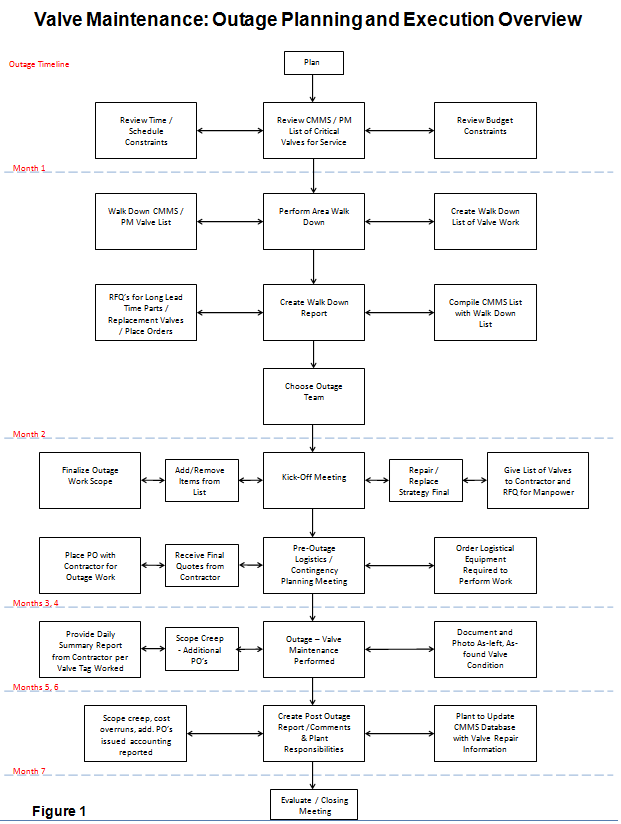Preparing for a Plant Outage
It is well known that effective planning can save time and curtail expenses when production and utility plant areas prepare for upcoming maintenance turnarounds, outages, and shut-downs.
#maintenance-repair
Also used for identifying control valves that need attention is a “walk down” of the plant systems involved in the outage. Such a walk down reduces the likelihood of missing or misidentifying the “bad actors” that need testing and repairs. It can help the process of prioritizing (or de-prioritizing) repairs or replacements based on condition, cost, accessibility, etc. It also can facilitate the documention of “as-left” conditions in a post-outage report, which will bring closure to the process and highlight performance issues that need to be addressed in the future.
Long before the planned outage date, facility, maintenance and/or reliability engineering personnel have usually established an estimated budget dedicated to testing, removal, and repair or replacement of problem valves. That budget may or may not be part of the overall maintenance budget for the fiscal year. Either way, ensuring that some form of cost-overrun allowance is planned can often facilitate decisions made in the middle of a crisis.
Facilities, maintenance, and/or reliability engineering staff, along with an operations representative, usually begin the outage planning process at least six months before the scheduled outage date. This team will set goals, milestones and key performance indicators based upon what they believe can realistically be accomplished.
Walking Down the Outage Area
Once operations and maintenance department agree upon an outage date, the next step will be determining what actual valve work needs to be accomplished during the outage. Walk downs can be performed by a qualified area technician, planner, facility or reliability engineer, contractor outage manager or an operations manager. The actual responsibilities of this person will vary by a number of variables, including outage scope, equipment complexity, accessibility and technical capabilities.
Among the factors the person will be tasked with doing is observing poorly performing valves, leaking flange connections, leaking stem seals and packing, noticeable air leaks, bad positioner air gauges, tubing damage and more. Abnormalities are documented, as well as the valve manufacturer, serial number, valve type, size, positioner, actuator, photos of the tag and a description of valve location. Noting these locations in great detail is very important so that the outage manager can plan the actual work to be performed. The more quickly valve technicians can move from valve-to-valve while keeping equipment and tool relocation distances to a minimum, the greater the efficiency of the process. Valve-specific information should already be electronically stored and associated with the valve tag in the CMMS or other relational database software program, but verification is still required. CMMS information also can be updated after the walk down.
If outside valve maintenance personal are contracted to perform valve repair or replacement during the outage, additional data should be gathered and included with the walk-down report. This data might include safety and medical treatment locations, parking locations, elevator and entry points, and other factors. Including such information into the walk down report assures maximum efficiency.
Walk-Down Report
The walk down report is vital part of establishing the scope of work to be performed during the outage. When the CMMS work tag list is compiled from the walk down, a preliminary valve work scope can be developed in preparation for a kick-off meeting.
PM programs and their associated CMMS documentation, along with everyday spare parts strategies, usually dictate that facilities keep some valve replacement and repair parts on-hand. Many facilities want to pull from their everyday repair/replacement inventory first for an outage or purchase repair/replacement parts before the outage to hold within stockrooms or storehouses. Other facilities prefer to rely on contractor-supplied valve replacement and repair parts. In many cases, a combination of these strategies is implemented. It is critical for the supply chain to address vendor lead times for replacement parts if those parts are not inventoried.
Once quotes have been received for parts and replacement valves from vendors (not including contractor-supplied material and manpower), a preliminary work list of valves can be created; the total number of man-hours to perform the valve work also can be estimated.
Outage Team
Who makes up the team can vary depending on the outage size and scope, and the skill sets needed to accomplish the valve work. Typical outage team members include the manager and people from procurement/purchasing, facilities and reliability engineering, the environment/safety/health representative, an area operations representative and maintenance personnel.
Communication between team members is vital, especially when tools, people, materials, and equipment are being moved around as the work progresses.
Kick-Off Meeting
How extensive a kick-off meeting will be depends on how much preparation is done upfront. The outage manager should facilitate and lead the meeting. It will cover issues such as defining the roles and responsibilities of the team members, defining the scope of work with valve tags, coming up with a replacement spare parts strategy, establishing valve repair budgets, a technical and application review, etc.
Although plant personnel are sometimes hesitant to invite contract personnel to the kick-off meeting, they shouldn’t be: such attendees can offer invaluable advice and lay out logistical requirements for the people performing the work. In addition, they can begin collecting the information required to prepare quotations for the manpower and materials needed.
Logistics Meeting
After the kick-off meeting, a pre-outage logistics meeting is advisable. Interdepartmental communication within the organization is vital here because the outage manager is planning and working out the logistics of “how, where, when, and who” will be using support equipment needed to perform the valve repair work. As with the kick-off meeting, the outage manager determines who should attend the logistics meeting, and a contract maintenance company representative can be invaluable during the meeting. Typical issues discussed include:
Ancillary support / logistic items: This is a discussion concerning the equipment and services required to perform the valve maintenance work. Some of the details to be considered include compressed air and power availability, loop power to valve positioners, cranes and man-lift availability, manuals and test equipment. In many instances, additional outage work takes place concurrently in areas adjacent to the valve repair locations, so sharing of cranes, hoists, rigging or man-lifts may be possible (and necessary).
Impact to outage timeline: Many factors can negatively impact the timeline as planning moves forward and the outage event takes place. Scope creep, rework, manpower issues, etc. are all very real impacts on schedule. Anticipating and addressing these situations may be the key to a successful outage.
Another timeline consideration is weather. Valves located outside on systems such as heat exchangers, flash steam condensate collection tanks, cooling towers and HVAC units will be impacted by any severe weather as will other factors such as equipment rental availability or employees’ ability to travel to work. Contingency plans should be made in case time or resources are limited.
As with permanent facility maintenance employees, contract outage employees should have access to safety equipment, training and certifications, work permits and facility areas. While contract employees would receive training and certifications before an outage, they will still need to complete applications for permits, complete badging forms, gather specific personal protection equipment and register their vehicles.
Generate purchase orders (PO) to contractor for parts and personnel: Based upon the quotations received from a contractor, purchase orders will be issued for repair parts, equipment and contract valve maintenance personnel. These POs must be finalized and issued to the contractor before the logistics meeting and outage. Often, valve technicians with specialized training, knowledge and skill sets may be needed and sometimes the contractor will find and employ new personnel to fulfill the needs. This reality, coupled with long lead times of ordered valve parts and repair kits, may require several months. The longer the contractor has to plan for the event, the better prepared the contractor personnel will be when they arrive on-site.
Outage Event
If planned properly, the outage work event should be the least eventful task, barring any major issues found or problems experienced. If all logistical requirements are planned out in advance, the movement of personnel, test equipment, tools, cranes/hoists, materials, and replacement valves, etc., will require less resource time than the actual repair to the valve.
As with normal daily maintenance, properly documenting and tracking the history of the valve work performed during the outage is as important as analyzing normal daily performance conditions. Such documentation includes:
As-found, as-repaired, as-left description and photo: When valves are evaluated, disassembled, repaired or replaced during the outage, a one or two sentence description stating what was accomplished and what parts were used should be completed as part of the daily summary report. Photos for each valve tag’s before-repair and after-repair should be taken to document as-found and as-left conditions. Additional photos documenting the condition of the valve trim, body, actuator and any accessories such as positioner, I/P transducer, filter regulator, relays, switches, solenoids, and more, are also helpful when reporting the repairs and deciding the disposition of the valve.
A simple status report of the work performed by tag number should be created and submitted to the outage manager daily. This report can be as simple as a spreadsheet that shows the intended original work scope, the actual work performed, the completion status, the number of hours spent repairing, what parts were used and when the task should be completed.
The information contained within the daily status report will be used to create the post outage report and will be combined with as-found photos and as-left photos of the valves repaired.
Post-Outage Report/Plant Responsibilities
After the outage occurs and relevant valve repair and replacement information has been collected, a post-outage report should be written by the outage manager. It should include a summary of the scope of work performed by both the plant personnel and the contractor personal—a spreadsheet summary organized by tag number with the valve serial number, description, as-found condition and photo, as-left condition and photo, and any comments or recommendations.
The plant will use the post-outage report information to update the CMMS so that valve repair histories can be referenced and PM schedules established for individual valve requirements.
Weighing the Success
Various stakeholders within the organization will evaluate the success, performance or failure of the completed valve work. This objective measuring and assessing of what worked and what did not is required to improve for outages to come. Success is viewed in terms of the key performance indicators met, goals accomplished and milestones reached as set-forth during the planning stages.
Some of the common criteria used for evaluating outage success include: financial, quality, timeline, material usage and non-usage, scope adherence and scope creep, and safety.
Once the post-outage report is completed and distributed to the appropriate outage team members, managers and stakeholders, an optional closing meeting can be held by the outage manager. Meeting attendees should be plant personnel only. The meeting addresses the details outlined in the report, which includes the work scope obtained or not obtained. The meeting gives team members a chance to ask questions and encourages discussion of valve issues still pending that need to be addressed. Lessons learned from analyzing what worked and what did not during the outage allow the plant to capitalize on positive actions and not repeat mistakes.
Outage Timeline
The outage planning and execution process requires communication between all participating departments before, during and after the outage. Soliciting and involving the maintenance contractor before the outage kick-off meeting ensures proper material and manpower estimates are accurate and quotations are delivered in a timely manner. An accurate outage work scope document can be developed by using information from the maintenance contractor, CMMS valve lists, and information gathered during the walk-down. Using the work scope information to organize operations and maintenance logistics before the outage minimizes negative impact to the timeline. Documenting all work performed in daily status reports along with as-found and as-left valve photos adds detail to the post-outage report. All of this information is required when the outage is evaluated by stakeholders.
Regardless of how facilities refer to their maintenance shut-downs, outages or turn-arounds, the events have similar goals: repair or replace critical systems and associated equipment in the shortest amount of time possible while spending the least amount of dollars. Reaching these goals can be accomplished by using a methodical, multi-step planning and outage management process as shown in Figure 1. The process can be changed to suite individual plant outage length and scope requirements, but the core steps should be followed.
David Matherly is a product manager of controls and instrumentation with Spirax Sarco Inc. He has over 30 years’ experience in instrumentation and controls and has held engineering, product management, marketing, and technical positions with a number of companies. Reach him at david.matherly@us.spiraxsarco.com.
RELATED CONTENT
-
Ball Valve Repair 101
From time to time, we are re-posting well-received or particularly valuable articles that have previously run on VALVEMagazine.com so that those who might have missed them will be able to catch up on the best of the best.
-
Creating a Standard for Severe Service Valves
Severe service valves are offered in several standard designs, including non-return, isolation and control types.
-
Cobalt-based Alloy 6 Materials and Boiler Feedwater Service
Q: I’ve heard that cobalt-base Alloy 6 materials should not be used in boiler feedwater service.











 Unloading large gate valve.jpg;maxWidth=214)


